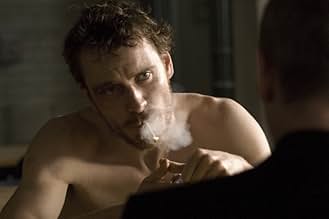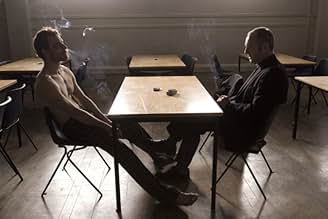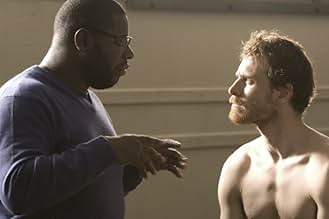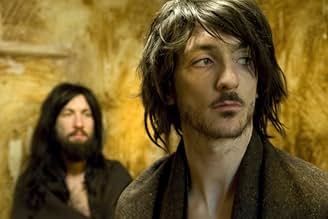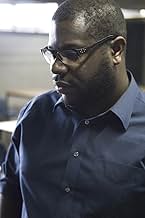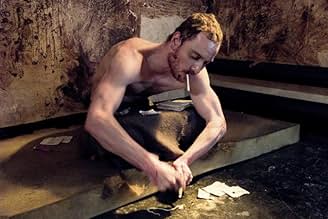आयरिश रिपब्लिकन बॉबी सैंड्स भूख हड़ताल में उत्तरी आयरिश जेल के कैदियों का नेतृत्व करते हैं।आयरिश रिपब्लिकन बॉबी सैंड्स भूख हड़ताल में उत्तरी आयरिश जेल के कैदियों का नेतृत्व करते हैं।आयरिश रिपब्लिकन बॉबी सैंड्स भूख हड़ताल में उत्तरी आयरिश जेल के कैदियों का नेतृत्व करते हैं।
- 1 BAFTA अवार्ड जीते गए
- 49 जीत और कुल 39 नामांकन
फ़ीचर्ड समीक्षाएं
The movie is a timely piece of film-making in this era of Abu Ghraib and Guantanamo Bay. I have to admit my prejudice for the film because of my past as one of the prisoners depicted in the film. Long Kesh or the Maze as the British infamously renamed it was the Abu Ghraib of its day. One stark difference though: unlike Abu Ghraib, no one has ever been charged with the horror and relentless torture inflicted upon naked, defenceless prisoners in Long Kesh. The film is uncompromising in its examination of the events leading up to and beyond the Hunger Strike. Michael Fassbender is frighteningly real. But I will leave it up to the words of Peter Bradshaw in the Guardian to sum it up: 'Hunger is raw, powerful film-making and an urgent reminder of this uniquely ugly, tragic and dysfunctional period in British and Irish history
'
1981.
The H block in Belfast's Maze Prison.
This film captures the development and escalation of protest by the 'political' prisoners held here as things moved through 'The 'Blanket protest' onto 'The Dirty Protest" and finally to 'The Hunger Strikes' that claimed Bobby Sands and eight of his compatriot's lives.
As the end credits of the film show, the enemy, in the form of Margaret Thatcher was 'not for turning' and did not grant political status to these men that she considered no more than murderers. They did, however, lead to many concessions - bit by bit.
This astounding movie falls into three very clear sections; the gut wrenching blanket and dirty protest; a long and deeply personal conversation (in one 20 minute take) between Sands and his priest where Sands is asked to justify and then walk away from the impending hunger strike; and finally Sands' ordeal itself.
Each section has a different pace and personality. Each is desperate in its own way.
This film pulls few punches. The stench of human excrement is almost palpable in the opening act and the way in which Michael Fassbender brings Sands' death to the screen is almost unbearable.
But the real triumph of the film is that it takes no political sides and makes no judgements but does not sit on the fence. How? Because it invokes the viewer to do that themselves. Sands is neither a figure to pity or to vilify. It really is quite remarkable that the artist Steve McQueen can achieve this so consistently.
And this is art with a capital A. Every scene is stunningly rendered. The pace, at times snail-like, allows you consider in real detail the situation these men found themselves in (or created however you want to look at it).
Fassbender's performance is miraculous.
McQueen though, is the star of the show. One scene in particular when the men slop out by pouring their night's urine under the doors of the corridor simultaneously is quite beautiful, as is the Hirst-like art that some of them create from their excrement (that's what makes up the poster image).
Film of the year. No contest.
Incidentally we saw it in the DCA's Cinema 2. What a cracking screen.
(As we scoffed coffee and fudge doughnuts. How's that for irony?)
The H block in Belfast's Maze Prison.
This film captures the development and escalation of protest by the 'political' prisoners held here as things moved through 'The 'Blanket protest' onto 'The Dirty Protest" and finally to 'The Hunger Strikes' that claimed Bobby Sands and eight of his compatriot's lives.
As the end credits of the film show, the enemy, in the form of Margaret Thatcher was 'not for turning' and did not grant political status to these men that she considered no more than murderers. They did, however, lead to many concessions - bit by bit.
This astounding movie falls into three very clear sections; the gut wrenching blanket and dirty protest; a long and deeply personal conversation (in one 20 minute take) between Sands and his priest where Sands is asked to justify and then walk away from the impending hunger strike; and finally Sands' ordeal itself.
Each section has a different pace and personality. Each is desperate in its own way.
This film pulls few punches. The stench of human excrement is almost palpable in the opening act and the way in which Michael Fassbender brings Sands' death to the screen is almost unbearable.
But the real triumph of the film is that it takes no political sides and makes no judgements but does not sit on the fence. How? Because it invokes the viewer to do that themselves. Sands is neither a figure to pity or to vilify. It really is quite remarkable that the artist Steve McQueen can achieve this so consistently.
And this is art with a capital A. Every scene is stunningly rendered. The pace, at times snail-like, allows you consider in real detail the situation these men found themselves in (or created however you want to look at it).
Fassbender's performance is miraculous.
McQueen though, is the star of the show. One scene in particular when the men slop out by pouring their night's urine under the doors of the corridor simultaneously is quite beautiful, as is the Hirst-like art that some of them create from their excrement (that's what makes up the poster image).
Film of the year. No contest.
Incidentally we saw it in the DCA's Cinema 2. What a cracking screen.
(As we scoffed coffee and fudge doughnuts. How's that for irony?)
Steve McQueen, a noted young British artist, has made a powerful first film about the Irish prisoners in H-Block of Maze Prison, Northern Ireland, and the hunger strike and death of Bobby Sands in 1981. The images are searing, both horrible and beautiful (McQueen is aware from Goya that images of war can be both), and much of the film is non-verbal, but the action is broken up by a centerpiece tour-de-force debate between Sands (Michael Fassbender) and Father Dominic Moran (Liam Cunningham) that is as intensely verbal as the rest is wordless. In Irish playwright Enda Walsh's rapid-fire dialogue quips are exchanged, then passionate declarations, in a duel that's like a killer tennis match: watching, we listen, and the camera, hitherto ceaselessly in motion, becomes still. Hunger, with its rich language, intense images, and devastating story, is surely one of the best English-language of the year, and it understandably won the Camera d'Or at Cannes for the best first film. Like the American Julian Schnabel, Steve McQueen is another visual artist who has turned out to be an astonishingly good filmmaker.
Faithful to the physical details of the H-blocks and the treatment of the prisoners, the film is still honed down to essentials and includes a series of sequences so intense it may take viewers a long time to digest them. As the film opens, an officer of the prison, Raymond Lohan (Stuart Graham), follows his normal routine. His knuckles are bloody and painful; later we learn why. His wife brings him sausage, rasher, and eggs.
Davey Gillen (Brian Milligan) a young Irish republican prisoner, tall, gaunt, and Christ-like, is brought into the prison. He refuses to wear the prison uniform, so, joining the Blanket protest, he's put in with fellow "non-conforming" prisoner Gerry Campbell (Liam McMahon) in a cell whose walls are smeared with feces. Those of us who were around when these events happened (Steve McQueen was 12, and remembers the coverage), remember them so well we could have seen these walls. Campbell shows Gillen hot to receive "comms" (communications) from visitors and pass them to their leader Bobby Sands at Sunday mass.
When prisoners agree to wear civilian garments, they're mocked by the "clown clothes" they're handed out and riot, screaming and yelling and tearing up everything in their cells. They also periodically collect their urine and pour it under their cell doors out into the prison hallway where the guards must walk. The result is a brutal punishment by the prison in which the prisoners are taken out to the hallway and beaten naked by a gauntlet of police in riot gear. An eventual repercussion is that Raymond Lohan is shot dead while visiting his catatonic mother in a home.
A poetic flourish of the meeting between Sands and Father Moran is Sands's story of going to the country as a Belfast boy on the cross country team and going down to a woods and a stream where he is the only one who dares to put a dying foal out of its misery by drowning it. The images this tale evoke become the objective correlative of Bobby's last thoughts when he is dying in the prison hospital.
The central issue was being treated as political prisoners. From 1972, paramilitary prisoners had held some of the rights of prisoners of war. This ended in March 1976 and the republican prisoners were sent to the new Maze Prison and its "H-blocks" near Belfast. Special Category Status for prisoners convicted of terrorist crimes was abolished by the English government. Hunger doesn't focus on ideology or public policy, other than to have the voice of Margaret Thatcher, in several orotund declarations, adamantly denying the validity of the republicans' cause or status. The Sands-Moran debate is more about feelings and tactics.
Another powerful contrast comes when Sand goes on the hunger strike and is taken to the clean, quiet setting of the hospital where he is lovingly cared for and visited by a good friend and his parents, who're even allowed to sleep there during his last days. Sands' condition is dramatic, heightened by horrible sores, and a report to his parents of the rapid damage to internal organs and heart that his fast will cause.
It was McQueen's decision to eschew a screenwriter in favor of a playwright for the script, and his choice of his near-contemporary Enda Walsh, an Irishman resident in London, was a wise one. McQueen determined the structure and inspired the paring down. Walsh makes the central verbal scene sing. Its intensity is such that it has no trouble at all competing with the harsh prison scenes. It is brilliant stroke. Great theater you could say, but the film's contribution is to make the whole train of events alive and human at a time when they are acutely relevant to the post 9/11 world of Guantanamo and Abu Ghraib.
Shown at Cannes, Telluride, and Toronto, included in the New York Film Festival 2008.
Faithful to the physical details of the H-blocks and the treatment of the prisoners, the film is still honed down to essentials and includes a series of sequences so intense it may take viewers a long time to digest them. As the film opens, an officer of the prison, Raymond Lohan (Stuart Graham), follows his normal routine. His knuckles are bloody and painful; later we learn why. His wife brings him sausage, rasher, and eggs.
Davey Gillen (Brian Milligan) a young Irish republican prisoner, tall, gaunt, and Christ-like, is brought into the prison. He refuses to wear the prison uniform, so, joining the Blanket protest, he's put in with fellow "non-conforming" prisoner Gerry Campbell (Liam McMahon) in a cell whose walls are smeared with feces. Those of us who were around when these events happened (Steve McQueen was 12, and remembers the coverage), remember them so well we could have seen these walls. Campbell shows Gillen hot to receive "comms" (communications) from visitors and pass them to their leader Bobby Sands at Sunday mass.
When prisoners agree to wear civilian garments, they're mocked by the "clown clothes" they're handed out and riot, screaming and yelling and tearing up everything in their cells. They also periodically collect their urine and pour it under their cell doors out into the prison hallway where the guards must walk. The result is a brutal punishment by the prison in which the prisoners are taken out to the hallway and beaten naked by a gauntlet of police in riot gear. An eventual repercussion is that Raymond Lohan is shot dead while visiting his catatonic mother in a home.
A poetic flourish of the meeting between Sands and Father Moran is Sands's story of going to the country as a Belfast boy on the cross country team and going down to a woods and a stream where he is the only one who dares to put a dying foal out of its misery by drowning it. The images this tale evoke become the objective correlative of Bobby's last thoughts when he is dying in the prison hospital.
The central issue was being treated as political prisoners. From 1972, paramilitary prisoners had held some of the rights of prisoners of war. This ended in March 1976 and the republican prisoners were sent to the new Maze Prison and its "H-blocks" near Belfast. Special Category Status for prisoners convicted of terrorist crimes was abolished by the English government. Hunger doesn't focus on ideology or public policy, other than to have the voice of Margaret Thatcher, in several orotund declarations, adamantly denying the validity of the republicans' cause or status. The Sands-Moran debate is more about feelings and tactics.
Another powerful contrast comes when Sand goes on the hunger strike and is taken to the clean, quiet setting of the hospital where he is lovingly cared for and visited by a good friend and his parents, who're even allowed to sleep there during his last days. Sands' condition is dramatic, heightened by horrible sores, and a report to his parents of the rapid damage to internal organs and heart that his fast will cause.
It was McQueen's decision to eschew a screenwriter in favor of a playwright for the script, and his choice of his near-contemporary Enda Walsh, an Irishman resident in London, was a wise one. McQueen determined the structure and inspired the paring down. Walsh makes the central verbal scene sing. Its intensity is such that it has no trouble at all competing with the harsh prison scenes. It is brilliant stroke. Great theater you could say, but the film's contribution is to make the whole train of events alive and human at a time when they are acutely relevant to the post 9/11 world of Guantanamo and Abu Ghraib.
Shown at Cannes, Telluride, and Toronto, included in the New York Film Festival 2008.
Hunger (2008) ****
Bobby Sand's story has been told before on screen, but never with such raw intensity and unrelenting artistry as in Hunger. The film is directed by Turner Prize winning artist Steve McQueen. While his art has often been part of the film medium, this is his first entry into feature film-making.
The film sparked both controversy and applause at this years Cannes Film Festival, with both disgusted walkouts and rousing ovation. It the end it landed McQueen the Camera D'or.
While the film follows the final weeks of Bobby Sand's hunger strike, it is equally about recreating the atmosphere and conditions inside the infamous Long Kesh Maze Prison. Its nearly a half hour into the film before we even meet Sands, in fact. We're introduced to a prison guard, who outside nervously checks his car for bombs, quietly avoids his comrades, then becomes as vicious as any other when brutalizing the inmates. We're also first introduced to a new inmate, who, as per the IRA standard, refuses to war a uniform and instead goes simply wrapped in a blanket. He and his cellmate smear the walls of their cells in feces as part of the no wash protest.
Bobby is played by Michael Fassbender, who gives a quietly powerful performance. For the film he underwent a medically supervised crash diet, one rivaling - if not outright surpassing - that of Christian Bale in the Machinist. He moves throughout the film with a sense of determination and dedication.
It is difficult to go into any detail about plot, as the film more or less moves patiently and quietly towards the inevitable. And the key word may be quiet. McQueen claimed that he originally envisioned doing the film dialogue free. Indeed, much of Hunger is free of dialogue. However, McQueen, as he puts it, felt it would be more powerful to go from vocal silence into an avalanche of dialogue. And so the films centerpiece was born - a 20 minute stationary shot of Bobby speaking with his Priest. In a film that is filled with a dark heaviness in a cruel prison atmosphere, that meeting lifts a weight for a time, before slowly descending into a sad sense of inevitability. Though that inevitability is liberating, it is nonetheless a profoundly sad one. The film also does not shy away from the cruelty of the British towards the Irish, though it also does not deny the brutality of the IRA at times - as characterized in one shocking moment. However, anyone with any inkling of rational knowledge on the Irish struggles knows that the IRA was never simply a terrorist organization, but a rebel group that did from time to time employ terrorist tactics. Like all anti-state organizations, however, the IRA did not exist for the sake of conflict, but because of callousness and cruelty. McQueen reminds us of the cruelty and arrogance of the British particularly through the cold words of Margaret Thatcher, speaking shamelessly about Sands' strike.
There have been many fantastic films about the Irish Struggles, with some of the best coming in recent years (Ken Loach's fantastic Wind that Shakes the Barley, and Paul Greengrass's Bloody Sunday, to name two of the better). This one, I think, may be the best. At least from an artistic and purely visceral standpoint. McQueen captures his scenes in jarring compositions, with all the skill and artistic imagining of a true artist. From the opening sequences, Hunger promises something more than just the standard. Whereas most political films focus all their attention on the message, Hunger focuses on the feeling, and never strays from its artistic goals. This is art, from its opening to closing frames. It's a boldly crafted and brave film. The cinematography and direction are assured, moving slowly and unexpectedly, always beautifully even in its darkest and dirtiest moments.
I believe this truly is a great masterpiece. McQueen has proved himself as a masterful artist of film-making as well with Hunger.
Bobby Sand's story has been told before on screen, but never with such raw intensity and unrelenting artistry as in Hunger. The film is directed by Turner Prize winning artist Steve McQueen. While his art has often been part of the film medium, this is his first entry into feature film-making.
The film sparked both controversy and applause at this years Cannes Film Festival, with both disgusted walkouts and rousing ovation. It the end it landed McQueen the Camera D'or.
While the film follows the final weeks of Bobby Sand's hunger strike, it is equally about recreating the atmosphere and conditions inside the infamous Long Kesh Maze Prison. Its nearly a half hour into the film before we even meet Sands, in fact. We're introduced to a prison guard, who outside nervously checks his car for bombs, quietly avoids his comrades, then becomes as vicious as any other when brutalizing the inmates. We're also first introduced to a new inmate, who, as per the IRA standard, refuses to war a uniform and instead goes simply wrapped in a blanket. He and his cellmate smear the walls of their cells in feces as part of the no wash protest.
Bobby is played by Michael Fassbender, who gives a quietly powerful performance. For the film he underwent a medically supervised crash diet, one rivaling - if not outright surpassing - that of Christian Bale in the Machinist. He moves throughout the film with a sense of determination and dedication.
It is difficult to go into any detail about plot, as the film more or less moves patiently and quietly towards the inevitable. And the key word may be quiet. McQueen claimed that he originally envisioned doing the film dialogue free. Indeed, much of Hunger is free of dialogue. However, McQueen, as he puts it, felt it would be more powerful to go from vocal silence into an avalanche of dialogue. And so the films centerpiece was born - a 20 minute stationary shot of Bobby speaking with his Priest. In a film that is filled with a dark heaviness in a cruel prison atmosphere, that meeting lifts a weight for a time, before slowly descending into a sad sense of inevitability. Though that inevitability is liberating, it is nonetheless a profoundly sad one. The film also does not shy away from the cruelty of the British towards the Irish, though it also does not deny the brutality of the IRA at times - as characterized in one shocking moment. However, anyone with any inkling of rational knowledge on the Irish struggles knows that the IRA was never simply a terrorist organization, but a rebel group that did from time to time employ terrorist tactics. Like all anti-state organizations, however, the IRA did not exist for the sake of conflict, but because of callousness and cruelty. McQueen reminds us of the cruelty and arrogance of the British particularly through the cold words of Margaret Thatcher, speaking shamelessly about Sands' strike.
There have been many fantastic films about the Irish Struggles, with some of the best coming in recent years (Ken Loach's fantastic Wind that Shakes the Barley, and Paul Greengrass's Bloody Sunday, to name two of the better). This one, I think, may be the best. At least from an artistic and purely visceral standpoint. McQueen captures his scenes in jarring compositions, with all the skill and artistic imagining of a true artist. From the opening sequences, Hunger promises something more than just the standard. Whereas most political films focus all their attention on the message, Hunger focuses on the feeling, and never strays from its artistic goals. This is art, from its opening to closing frames. It's a boldly crafted and brave film. The cinematography and direction are assured, moving slowly and unexpectedly, always beautifully even in its darkest and dirtiest moments.
I believe this truly is a great masterpiece. McQueen has proved himself as a masterful artist of film-making as well with Hunger.
Hunger is a powerful and disturbing feature-film debut for the visual artist Steve McQueen. The film takes place almost exclusively within the confines of a high-security prison in Northern Ireland, where many members of the Irish Republican Army are interned. The small confines of the prison serve as a microcosm of the wider Troubles in Ireland. The conflict between the British wardens and the Irish inmates escalates steadily, with each indignity and abuse inevitably leading to another.
The conditions revealed in the prison are deeply disturbing, with the inmates fouling the jail with effluent and the guards responding with ritual humiliation and savage beatings. McQueen's camera is an unflinching witness to the squalor and cruelty, and with the vivid imagery and forceful sounds it is almost possible to smell and feel the frightening environs of the film.
Although the focus of the film ultimately falls on Bobby Sands, the IRA member and inmate who leads a fatal hunger strike within the prison, we are not introduced to the main protagonist until a third of the way through the film. This approach works remarkably well in setting the scene for the main narrative, but it is disappointing that the different perspectives on each side are somewhat sidelined thereafter, as Sands's personal struggle takes centre stage.
The terrible squalor of the prison cells provides some of the film's most powerful images, but it is the second third of the film that is the most gripping, as Sands converses and argues with a visiting Catholic priest. An unmoving camera is trained upon these two protagonists for what must be nearly half an hour, as Sands reveals his plan for a new hunger strike and defends his methods of achieving political goals, ultimately berating what he sees as the priest's despondency and inertia. This is an utterly compelling piece of cinema.
However, at the end of this gripping conversation, the director sees fit to insert a somewhat tortured analogy as Sands recalls for the priest a defining moment of his boyhood. This is an unnecessary effort to inject conventional beauty into Sands's story, and sits awkwardly with the general tone of the film.
In the final third of the film, the hunger strike is depicted in by now characteristically brutal detail. Lead man Michael Fassbender clearly underwent a very painful regime to portray the wasting and withering of Bobby Sands in his last days. Unfortunately, amidst the impressive attention to detail, McQueen goes further in romanticising his main protagonist through a series of flashbacks to Sands's childhood. This again jars with the realistic feel of the rest of the film, and points to McQueen's obsession with Sands, which he has admitted to having had since a young age.
Although at times steering a little close to hagiography, McQueen's directorial debut is still a bold and engrossing film that cultivates an understanding for the very different people caught in up in the Troubles in Northern Ireland. It will be fascinating to see what his next project will be.
The conditions revealed in the prison are deeply disturbing, with the inmates fouling the jail with effluent and the guards responding with ritual humiliation and savage beatings. McQueen's camera is an unflinching witness to the squalor and cruelty, and with the vivid imagery and forceful sounds it is almost possible to smell and feel the frightening environs of the film.
Although the focus of the film ultimately falls on Bobby Sands, the IRA member and inmate who leads a fatal hunger strike within the prison, we are not introduced to the main protagonist until a third of the way through the film. This approach works remarkably well in setting the scene for the main narrative, but it is disappointing that the different perspectives on each side are somewhat sidelined thereafter, as Sands's personal struggle takes centre stage.
The terrible squalor of the prison cells provides some of the film's most powerful images, but it is the second third of the film that is the most gripping, as Sands converses and argues with a visiting Catholic priest. An unmoving camera is trained upon these two protagonists for what must be nearly half an hour, as Sands reveals his plan for a new hunger strike and defends his methods of achieving political goals, ultimately berating what he sees as the priest's despondency and inertia. This is an utterly compelling piece of cinema.
However, at the end of this gripping conversation, the director sees fit to insert a somewhat tortured analogy as Sands recalls for the priest a defining moment of his boyhood. This is an unnecessary effort to inject conventional beauty into Sands's story, and sits awkwardly with the general tone of the film.
In the final third of the film, the hunger strike is depicted in by now characteristically brutal detail. Lead man Michael Fassbender clearly underwent a very painful regime to portray the wasting and withering of Bobby Sands in his last days. Unfortunately, amidst the impressive attention to detail, McQueen goes further in romanticising his main protagonist through a series of flashbacks to Sands's childhood. This again jars with the realistic feel of the rest of the film, and points to McQueen's obsession with Sands, which he has admitted to having had since a young age.
Although at times steering a little close to hagiography, McQueen's directorial debut is still a bold and engrossing film that cultivates an understanding for the very different people caught in up in the Troubles in Northern Ireland. It will be fascinating to see what his next project will be.
क्या आपको पता है
- ट्रिवियाHunger is known for its unbroken 17 minute 10 second continuous shot, in which Catholic priest Father Dominic Moran tries to talk Bobby Sands out of the Hunger Strike he and his fellow 75 IRA members plan to start. The camera remains in the same position throughout the scene. To prepare, Liam Cunningham moved into Michael Fassbender's apartment, and they rehearsed the scene 12-15 times per day. On the first day of filming, the actors got it perfect after 4 takes.
- गूफ़Thatcher's speech that says "the men of violence have chosen in recent months to play what may well be their last card" is shown in the film when the hunger strike is beginning, but it was actually made after Bobby Sands had died. It was made on 28th May 1981. Bobby Sands died on 5th May 1981.
- भाव
Bobby Sands: I have my belief, and in all its simplicity that is the most powerful thing.
- कनेक्शनFeatured in Front Row: Michael Fassbender/Kate Winslet (2017)
- साउंडट्रैकIndustry
Performed by Maya Beiser
Composed by Michael Gordon
Published by Red Poppy in association with G. Schirmir, Inc.
टॉप पसंद
रेटिंग देने के लिए साइन-इन करें और वैयक्तिकृत सुझावों के लिए वॉचलिस्ट करें
विवरण
- रिलीज़ की तारीख़
- कंट्री ऑफ़ ओरिजिन
- आधिकारिक साइट
- भाषाएं
- इस रूप में भी जाना जाता है
- Tù Khổ Sai
- फ़िल्माने की जगहें
- उत्पादन कंपनियां
- IMDbPro पर और कंपनी क्रेडिट देखें
बॉक्स ऑफ़िस
- बजट
- £15,00,000(अनुमानित)
- US और कनाडा में सकल
- $1,54,084
- US और कनाडा में पहले सप्ताह में कुल कमाई
- $1,980
- 7 दिस॰ 2008
- दुनिया भर में सकल
- $31,85,113
- चलने की अवधि1 घंटा 36 मिनट
- रंग
- ध्वनि मिश्रण
- पक्ष अनुपात
- 2.35 : 1
इस पेज में योगदान दें
किसी बदलाव का सुझाव दें या अनुपलब्ध कॉन्टेंट जोड़ें




